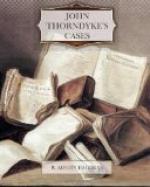Mr. Loewe leaped from his chair. “Let us go—now—at once—there is no time to be lost. A thousand thanks to you, doctor—a thousand million thanks. Come!”
He seized the inspector by the arm and forcibly dragged him towards the door, and a few moments later we heard the footsteps of our visitors clattering down the stairs.
“It was not worth while to enter into explanations with them,” said Thorndyke, as the footsteps died away—“nor perhaps with you?”
“On the contrary,” I replied, “I am waiting to be fully enlightened.”
“Well, then, my inferences in this case were perfectly simple ones, drawn from well-known anthropological facts. The human race, as you know, is roughly divided into three groups—the black, the white, and the yellow races. But apart from the variable quality of colour, these races have certain fixed characteristics associated especially with the shape of the skull, of the eye-sockets, and the hair.
“Thus in the black races the skull is long and narrow, the eye-sockets are long and narrow, and the hair is flat and ribbon-like, and usually coiled up like a watch-spring. In the white races the skull is oval, the eye-sockets are oval, and the hair is slightly flattened or oval in section, and tends to be wavy; while in the yellow or Mongol races, the skull is short and round, the eye-sockets are short and round, and the hair is straight and circular in section. So that we have, in the black races, long skull, long orbits, flat hair; in the white races, oval skull, oval orbits, oval hair; and in the yellow races, round skull, round orbits, round hair.
“Now, in this case we had to deal with a very short round skull. But you cannot argue from races to individuals; there are many short-skulled Englishmen. But when I found, associated with that skull, hairs which were circular in section, it became practically certain that the individual was a Mongol of some kind. The mother-of-pearl dust and the granules of rice starch from the inside of the hat favoured this view, for the pearl-shell industry is specially connected with China and Japan, while starch granules from the hat of an Englishman would probably be wheat starch.
“Then as to the hair: it was, as I mentioned to you, circular in section, and of very large diameter. Now, I have examined many thousands of hairs, and the thickest that I have ever seen came from the heads of Japanese; but the hairs from this hat were as thick as any of them. But the hypothesis that the burglar was a Japanese received confirmation in various ways. Thus, he was short, though strong and active, and the Japanese are the shortest of the Mongol races, and very strong and active.




